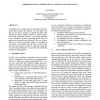Free Online Productivity Tools
i2Speak
i2Symbol
i2OCR
iTex2Img
iWeb2Print
iWeb2Shot
i2Type
iPdf2Split
iPdf2Merge
i2Bopomofo
i2Arabic
i2Style
i2Image
i2PDF
iLatex2Rtf
Sci2ools
WSC
2008
2008
Embedding human scheduling in a steel plant simulation
A simulation was commissioned to understand the interactions that constrain the capacity of a steel plant. The aim was for this to become a reusable tool that could evaluate the effect of future changes to market requirements and operational practices. This paper describes how a simulation model incorporating human decisionmaking was conceived and constructed. The use of simulation as a tool for knowledge capture in scheduling is considered. The resulting tool has been in use for four years and has acted as a driver to reconsider where the real processing bottlenecks are and what part scheduling can play in managing them.
| Added | 02 Oct 2010 |
| Updated | 02 Oct 2010 |
| Type | Conference |
| Year | 2008 |
| Where | WSC |
| Authors | David Briggs |
Comments (0)

